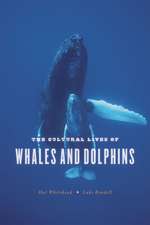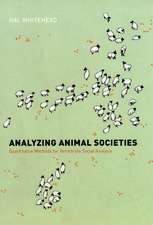Sperm Whales: Social Evolution in the Ocean
Autor Hal Whiteheaden Limba Engleză Paperback – 14 aug 2003
Famed in story as "the great leviathans," sperm whales are truly creatures of extremes. Giants among all whales, they also have the largest brains of any creature on Earth. Males can reach a length of sixty-two feet and can weigh upwards of fifty tons.
With this book, Hal Whitehead gives us a clearer picture of the ecology and social life of sperm whales than we have ever had before. Based on almost two decades of field research, Whitehead describes their biology, behavior, and habitat; how they organize their societies; and how their complex lifestyles may have evolved in this unique environment. Among the many fascinating topics he explores is the crucial role that culture plays in the life of the sperm whale, and he traces the consequences of this argument for both evolution and conservation. Finally, drawing on these findings, Whitehead builds a general model of how the ocean environment influences social behavior and cultural evolution among mammals as well as other animals.
The definitive portrait of a provocative creature, Sperm Whales will interest animal behaviorists, conservationists, ecologists, and evolutionary biologists as well as marine mammalogists.
With this book, Hal Whitehead gives us a clearer picture of the ecology and social life of sperm whales than we have ever had before. Based on almost two decades of field research, Whitehead describes their biology, behavior, and habitat; how they organize their societies; and how their complex lifestyles may have evolved in this unique environment. Among the many fascinating topics he explores is the crucial role that culture plays in the life of the sperm whale, and he traces the consequences of this argument for both evolution and conservation. Finally, drawing on these findings, Whitehead builds a general model of how the ocean environment influences social behavior and cultural evolution among mammals as well as other animals.
The definitive portrait of a provocative creature, Sperm Whales will interest animal behaviorists, conservationists, ecologists, and evolutionary biologists as well as marine mammalogists.
Preț: 338.19 lei
Nou
Puncte Express: 507
Preț estimativ în valută:
64.71€ • 69.20$ • 53.96£
64.71€ • 69.20$ • 53.96£
Carte tipărită la comandă
Livrare economică 18 aprilie-02 mai
Preluare comenzi: 021 569.72.76
Specificații
ISBN-13: 9780226895185
ISBN-10: 0226895181
Pagini: 456
Ilustrații: 60 halftones, 84 line drawings, 41 tables
Dimensiuni: 152 x 229 x 33 mm
Greutate: 0.72 kg
Ediția:1
Editura: University of Chicago Press
Colecția University of Chicago Press
ISBN-10: 0226895181
Pagini: 456
Ilustrații: 60 halftones, 84 line drawings, 41 tables
Dimensiuni: 152 x 229 x 33 mm
Greutate: 0.72 kg
Ediția:1
Editura: University of Chicago Press
Colecția University of Chicago Press
Notă biografică
Hal Whitehead is the Killam Professor in the Department of Biology at Dalhousie University in Canada. He is the author of Voyage to the Whales and coeditor of Cetacean Societies: Field Studies of Dolphins and Whales, the latter published by the University of Chicago Press.
Cuprins
Acknowledgments
Conventions
Symbols and Abbreviations
Prologue: Observations of Sperm Whale Societies
1 The Sperm Whale: An Animal of Extremes
1.1 Social Complexity in the Ocean
1.2 Evolutionary History of the Sperm Whale
1.3 Morphology: What Does the Sperm Whale Look Like?
1.4 The Peculiar Anatomy of the Sperm Whale: The Spermaceti Organ
1.5 The Lives and Populations of Sperm Whales
1.6 Sperm Whales and Humans
Box 1.1 The Sperm Whale in Print
1.7 What Is Social Structure, and How Is It Studied in Sperm Whales?
1.8 What Is Culture, and How Is It Studied in Sperm Whales?
1.9 What Do We Know and What Don't We Know about Sperm Whale Societies?
1.10 Summary
2 The Oceanic Habitat of the Sperm Whale
2.1 Spatio-Temporal Structure of the Ocean
2.2 Oceanographic Habitat of the Sperm Whale
2.3 The Diet of the Sperm Whale: The Walnut, the Pea, and the Half-Pound Steak
Box 2.1 An Alternative View of the Sperm Whale Diet: The Picky Eater
2.4 The Sperm Whale and Its Competitors
2.5 The Ecological Role of the Sperm Whale
2.6 Feeding Success of the Sperm Whale
2.7 Intraspecific Competition
2.8 Natural Enemies
2.9 Attack, Defense, and Escape in the Ocean
2.10 Summary
3 The Sperm Whale: On the Move through an Ocean
3.1 Why Movement Is Crucial
3.2 Vertical Movements: The Sperm Whale's Dive
3.3 Costs and Benefits of Vertical Movement
3.4 Horizontal Movements of Females and Immatures
3.5 Movements of Males
3.6 Movements of Other Oceanic and Terrestrial Animals
3.7 Costs and Benefits of Horizontal Movement
Box 3.1 How Fast Should a Sperm Whale Swim?
3.8 Summary
4 Sperm Whale Populations
4.1 Geographic Structure
4.2 The Sizes of Sperm Whale Populations
Box 4.1 Methods of Assessing Sperm Whale Populations
4.3 Population Parameters
4.4 Population Dynamics
Box 4.2 Changes in Sperm Whale Populations off the Galápagos Islands, 1985-2002
4.5 Summary
5 Sperm Whale Behavior and Vocalizations
5.1 Measuring Behavior
5.2 Vocalizations
Box 5.1 Are Sperm Whale Clicks Echolocation?
Box 5.2 Measures of Sperm Whale Behavior
5.3 Modes of Behavior
5.4 Foraging
5.5 Socializing
5.6 Aerial Behavior (and Other Peculiar Activities)
5.7 Birthing
5.8 Behavior of the Calf
5.9 Defense against Predators
Box 5.3 Interactions between Sperm Whales and Killer Whales
5.10 Stranding
5.11 Summary
6 Sperm Whale Societies
6.1 Social Scales
6.2 Concentrations
6.3 Aggregations
6.4 Groups
Box 6.1 The Problems of Estimating Group Size
6.5 Social Units
Box 6.2 Delineating Social Units
6.6 Genetic Structure of Groups and Units
6.7 The Functions of Groups and Units
Box 6.3 A Week in the Life of a Sperm Whale Group
6.8 The Cluster
6.9 Care of the Calf
6.10 The Social Male?
6.11 Mating Systems
Box 6.4 An Observation of Two Male Sperm Whales Fighting
6.12 Summary
7 Sperm Whale Cultures
7.1 The Quest for Sperm Whale Culture
7.2 Coda Dialects of Units and Clans
Box 7.1 Describing and Comparing Coda Repertoires
Box 7.2 Sperm Whale Clans of the South Pacific
7.3 Nonvocal Cultural Traits of Sperm Whales
7.4 Low Mitochondrial DNA Diversity and Culture: Cultural Hitchhiking
7.5 Summary
8 Social and Cultural Evolution in the Ocean
8.1 Evolution to Extremes
8.2 The Function and Evolution of a Big Nose
Box 8.1 The Spermaceti Organ: A Buoyancy Control Device or a Battering Ram?
8.3 The Function and Evolution of a Large Brain
8.4 Sperm Whales and Other Deep Divers
8.5 The Colossal Convergence: Sperm Whales and Elephants
8.6 K-Selection, Sociality, and Ecological Success
8.7 Social Evolution of Female Sperm Whales: Facing the Predators
8.8 The Lives of Males
8.9 Sexual Segregation
8.10 Social Evolution in the Open Ocean
8.11 Cultural Evolution in the Ocean
8.12 Summary
9 Sperm Whales and the Future
9.1 Ghosts of Past Whaling
9.2 The New Threats to Sperm Whales
9.3 Studying Sperm Whales in the Future
9.4 The Nature and Future of the Sperm Whale
9.5 Summary
Appendix: How We Study the Sperm Whale
A.1 Examining Carcasses
A.2 Studying Living Animals
A.3 Photoidentification and Photographic Measurement: The Key to Individuals
A.4 Quantifying Sounds
A.5 Unraveling Genes
References
Index
Conventions
Symbols and Abbreviations
Prologue: Observations of Sperm Whale Societies
1 The Sperm Whale: An Animal of Extremes
1.1 Social Complexity in the Ocean
1.2 Evolutionary History of the Sperm Whale
1.3 Morphology: What Does the Sperm Whale Look Like?
1.4 The Peculiar Anatomy of the Sperm Whale: The Spermaceti Organ
1.5 The Lives and Populations of Sperm Whales
1.6 Sperm Whales and Humans
Box 1.1 The Sperm Whale in Print
1.7 What Is Social Structure, and How Is It Studied in Sperm Whales?
1.8 What Is Culture, and How Is It Studied in Sperm Whales?
1.9 What Do We Know and What Don't We Know about Sperm Whale Societies?
1.10 Summary
2 The Oceanic Habitat of the Sperm Whale
2.1 Spatio-Temporal Structure of the Ocean
2.2 Oceanographic Habitat of the Sperm Whale
2.3 The Diet of the Sperm Whale: The Walnut, the Pea, and the Half-Pound Steak
Box 2.1 An Alternative View of the Sperm Whale Diet: The Picky Eater
2.4 The Sperm Whale and Its Competitors
2.5 The Ecological Role of the Sperm Whale
2.6 Feeding Success of the Sperm Whale
2.7 Intraspecific Competition
2.8 Natural Enemies
2.9 Attack, Defense, and Escape in the Ocean
2.10 Summary
3 The Sperm Whale: On the Move through an Ocean
3.1 Why Movement Is Crucial
3.2 Vertical Movements: The Sperm Whale's Dive
3.3 Costs and Benefits of Vertical Movement
3.4 Horizontal Movements of Females and Immatures
3.5 Movements of Males
3.6 Movements of Other Oceanic and Terrestrial Animals
3.7 Costs and Benefits of Horizontal Movement
Box 3.1 How Fast Should a Sperm Whale Swim?
3.8 Summary
4 Sperm Whale Populations
4.1 Geographic Structure
4.2 The Sizes of Sperm Whale Populations
Box 4.1 Methods of Assessing Sperm Whale Populations
4.3 Population Parameters
4.4 Population Dynamics
Box 4.2 Changes in Sperm Whale Populations off the Galápagos Islands, 1985-2002
4.5 Summary
5 Sperm Whale Behavior and Vocalizations
5.1 Measuring Behavior
5.2 Vocalizations
Box 5.1 Are Sperm Whale Clicks Echolocation?
Box 5.2 Measures of Sperm Whale Behavior
5.3 Modes of Behavior
5.4 Foraging
5.5 Socializing
5.6 Aerial Behavior (and Other Peculiar Activities)
5.7 Birthing
5.8 Behavior of the Calf
5.9 Defense against Predators
Box 5.3 Interactions between Sperm Whales and Killer Whales
5.10 Stranding
5.11 Summary
6 Sperm Whale Societies
6.1 Social Scales
6.2 Concentrations
6.3 Aggregations
6.4 Groups
Box 6.1 The Problems of Estimating Group Size
6.5 Social Units
Box 6.2 Delineating Social Units
6.6 Genetic Structure of Groups and Units
6.7 The Functions of Groups and Units
Box 6.3 A Week in the Life of a Sperm Whale Group
6.8 The Cluster
6.9 Care of the Calf
6.10 The Social Male?
6.11 Mating Systems
Box 6.4 An Observation of Two Male Sperm Whales Fighting
6.12 Summary
7 Sperm Whale Cultures
7.1 The Quest for Sperm Whale Culture
7.2 Coda Dialects of Units and Clans
Box 7.1 Describing and Comparing Coda Repertoires
Box 7.2 Sperm Whale Clans of the South Pacific
7.3 Nonvocal Cultural Traits of Sperm Whales
7.4 Low Mitochondrial DNA Diversity and Culture: Cultural Hitchhiking
7.5 Summary
8 Social and Cultural Evolution in the Ocean
8.1 Evolution to Extremes
8.2 The Function and Evolution of a Big Nose
Box 8.1 The Spermaceti Organ: A Buoyancy Control Device or a Battering Ram?
8.3 The Function and Evolution of a Large Brain
8.4 Sperm Whales and Other Deep Divers
8.5 The Colossal Convergence: Sperm Whales and Elephants
8.6 K-Selection, Sociality, and Ecological Success
8.7 Social Evolution of Female Sperm Whales: Facing the Predators
8.8 The Lives of Males
8.9 Sexual Segregation
8.10 Social Evolution in the Open Ocean
8.11 Cultural Evolution in the Ocean
8.12 Summary
9 Sperm Whales and the Future
9.1 Ghosts of Past Whaling
9.2 The New Threats to Sperm Whales
9.3 Studying Sperm Whales in the Future
9.4 The Nature and Future of the Sperm Whale
9.5 Summary
Appendix: How We Study the Sperm Whale
A.1 Examining Carcasses
A.2 Studying Living Animals
A.3 Photoidentification and Photographic Measurement: The Key to Individuals
A.4 Quantifying Sounds
A.5 Unraveling Genes
References
Index




















